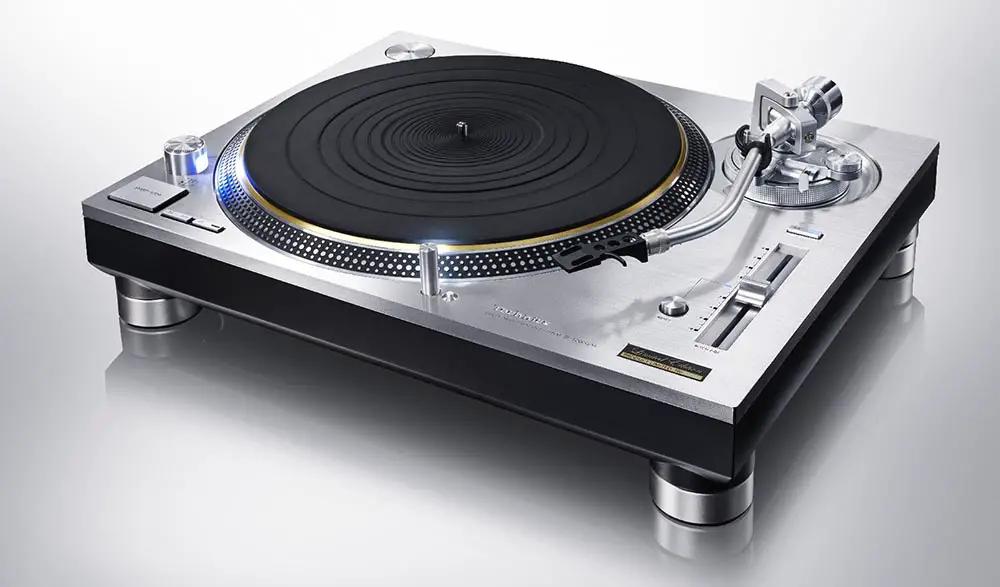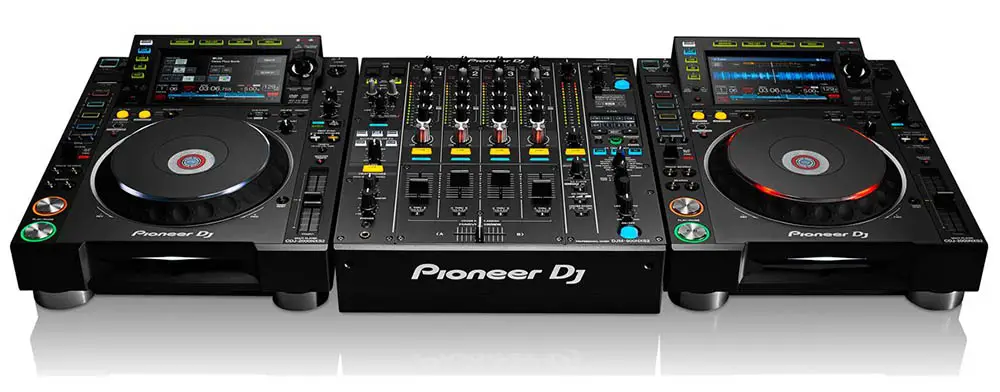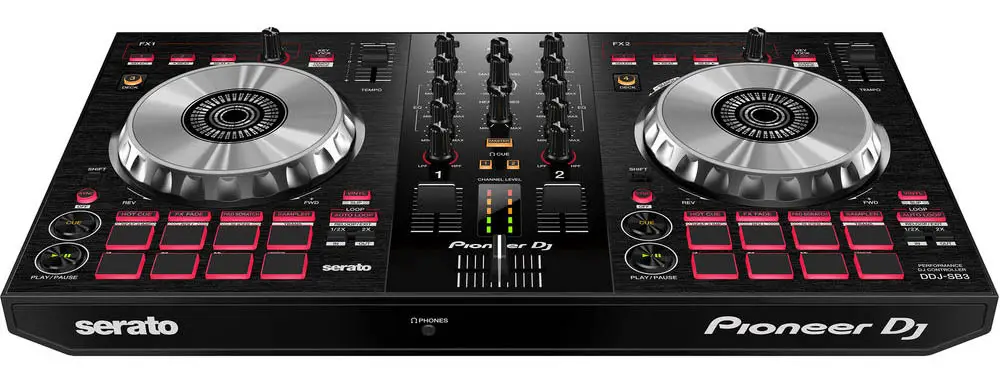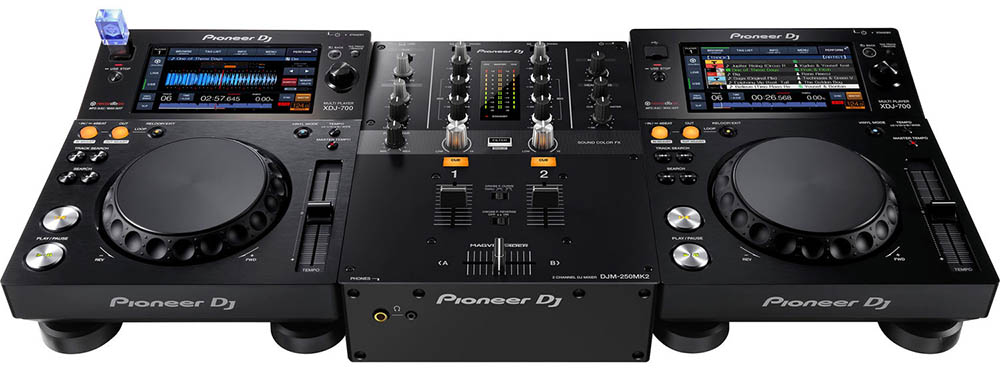DJ Starter Kit with Speakers
So you’ve chosen to take up DJing? Great choice – congratulations! You’re now probably browsing some gear and thinking “oh man, how do I choose where to invest my cash?!”
It’s a tough question to answer for sure – there is more gear on offer than ever before – and there are a number of routes you can go down as a DJ. No single route is the right choice. It’s difficult to put forward one particular starter kit and say ‘this is the best’ because there’s so much choice on offer.
So, let’s go over the various options and suggest the best DJ starter kit with speakers you can get right now.
What do you Need to Start DJing? The Old School
It varies but the basic components of a DJ setup are two turntables/decks, a mixer and speakers.
Back in the 90s or before, a DJ would use vinyl turntables hooked up to a simple two channel mixer. This would enable him/her to mix between two records, either by EQing and transitioning gradually between them or by beatmatching so the tunes can be mixed seamlessly.
Soon, scratching developed as a DJ technique, vastly transforming the sonic palette of DJing.
There are still plenty of DJs who go for the all-vinyl approach. It’s respected like no other form of DJing and some old school scratchers, like Jazzy Jeff are now world-famous DJs.
If you want to spin vinyl then your starter kit is simple. You’ll need a two-channel mixer, often referred to as a ‘battle mixer’, and two vinyl turntables.
Turntables built by Technics are the most iconic and widely used but Pioneer’s modern turntable is the strongest modern contender for best ever turntable.

What do you Need to Start DJing? The New School
If you’re looking beyond vinyl then the good news is that you’ll have a more powerful, flexible, modern and overall cheaper setup.
Vinyl is all good but it’s become pretty niche – we get that you can’t beat whacking on an old crackly record but for DJing through club systems, vinyl isn’t really practical.
It’s no surprise that the vast, vast majority of new and aspiring DJs are going down the digital route – it’s a sensible choice for so many reasons
-
CDJs

CDJ decks and a mixer are the most common in-house DJ setups. CDJs are basically super-complex CD players, which enabled you to play music from a CD, which is far more convenient than vinyl thanks to the ability to write and rewrite music.
Now, CDJs have evolved to work with USB sticks, which is a far more common choice amongst DJs. Instead of inserting a CD, you insert a USB stick which contains playlist data and track information.
You load the USB stick with a software called RekordBox, which is owned by Pioneer. Even CDJs manufactured by non-Pioneer brands, like Denon, use RekordBox.
CDJ Pros:
- Club-ready setup – the professional DJ solution found in many clubs worldwide
- Powerful and flexible
- No need to take anything other than your USB to a CDJ-equipped club or event
CDJ Cons:
- Expensive – requires external mixer
- Bulky and difficult to transport
CDJ Starter Kit
Pioneer runs the roost here and at clubs, you will only see Pioneer CDJs, the most powerful being the CDJ-2000NXS2 which costs whopping $1,998 per deck!
For a starter kit, we recommend a pair of Pioneer CDJ 350B decks. These cover all the basics and show BPMs to 1 decimal place, which is something that many older Pioneer decks don’t do.
-
The DJ Controller

The most popular route for new and existing DJs of all levels right now is the DJ controller. DJ controllers are portable, convenient, powerful and efficient to use for anything from house parties to clubs like Ministry and The Bergheim.
DJ controllers are units that combine 3 or more pieces of DJ gear together into one:
- Two jogwheels/decks
- A mixer with faders and EQ
- Lots of extra controls including FX and trigger/sample pads
DJ controllers work in one of two ways:
- Connected to a computer running RekordBox, Serato, Virtual DJ or Traktor.
This is the most popular route. You have your music loaded into DJ software on your laptop where you can organize sets/playlists. This connects to the controller via USB. You will need to bring both with you to DJ.
- As a standalone unit with playlists loaded onto USB sticks (only possible with Pioneer controllers.
This method doesn’t utilize a computer or laptop. Playlists are first created on RekordBox, which is music preparation software. These playlists are then exported to USB sticks which can be plugged directly into the decks. Built LCD screens display track information, just like a CDJ or laptop would). You won’t need to bring a PC or laptop with you to DJ – just a USB.
DJ Controller Pros:
- Convenient and portable
- Flexible and powerful with lots of controls
- Is becoming the benchmark in many major clubs
- Comparatively cheap
- Won’t need a mixer
DJ Controller Cons:
- You’ll need to bring your controller and laptop to gigs (clubs don’t usually have an in-house controller as there are too many models from too many brands)
- Need a relatively powerful laptop (if you’re not using a standalone DJ controller from Pioneer
DJ Controller Starter Kits
- If you’re opting for the first setup, where you’re using a laptop with DJ software then the Numark Mixtrack Pro 3 DJ Controller is an awesome budget controller which runs on Serato DJ.
- If you’re opting for the standalone route then you don’t have any choice other than Pioneer. The Pioneer XDJ-RR is the cheapest option.
Mixers for a DJ Starter Kit
Those in the DJ controller camp don’t need a mixer. DJ controllers contain mixers with EQ etc built, which saves you a chunk!
Those in the CDJ camp – you’ll need a mixer. The advantage of a mixer is that you can expand your setup with more decks and equipment.
The industry benchmark for mixers? You guessed it – Pioneer.
The Pioneer DJM range is the most well-known range of mixers in the world. DJM mixers vary from the DJM 250 – a two channel battle mixer to the DJM 750 – a larger 4 channel mixer, the club benchmark.

- If you only need a two-channel mixer then the DJM 350 has some built-in FX which come in handy for CDJ mixing. The DJM 250 is the smallest mixer of the pro Pioneer DJM range.
- Allen & Heath, arguably Pioneer’s biggest competitor, offer a similar mixer the XONE 23.
- If you want 4 channels for the connection of 4 turntables then the Numark M6 USB is a decent quality low-cost solution.
- Despite their mixed reputation as a manufacturer, the Behringer DJX750 is a real workhorse budget 4 channel mixer, ideal for a DJ starter set.
DJ Starter Kit: Speakers
Last but never least, you’ll need some speakers.
Speakers are one of two types and understand the importance is absolutely vital.
- Powered Speakers
Powered speakers do not require external amplification. You plug them into a mains power socket and into your mixer output via XLR or RCA and you’re good to go – you just need the two speakers and nothing else.
The Best Powered Speakers for a DJ Starter Kit
- KRK Rokit 5. Everyone knows what a Rockit looks like! They’re the most common smallish powered speaker used by DJs and producers by far.
- PreSonus Eris E5. A great alternative to the Rockit 5, this 5-inch powered speaker is slightly cheaper than the Rockit 5 also whilst packing a similar spec.
- Mackie CR range. Coming in sizes ranging from 3 inch to 5 inches, the Mackie CR range weigh in as cheaper than either the Eris range or Rockit range and represent great value for money
- Unpowered or Passive Speakers
Unpowered speakers need an external amplifier to work. You’d plug your mixer output into the amplifier and then plug the speakers into the amplifier. Passive speakers generally provide more power for less money.
- Behringer MS40. A small passive speaker, the Behringer MS40 is highly detailed and excellent value.
- KRK Rokit RS6. This high-performance passive monitor speaker is the benchmark for its price.
So, what is THE best DJ Starter Kit?!
If you were hoping for an easy answer…
The best DJ starter kit is probably a DJ controller with some powered speakers mentioned in this article.
Benefits of this setup:
- Pro-capable mixing facilities with decks and mixer
- A transportable solution that can be easily set up at home or in venues
- No need to bother with amps – just plug your speakers in and turn them up
- You can choose whether you want to mix with Serato, Traktor, RekordBox or Virtual DJ or want to mix with USB sticks on a standalone Pioneer controller
- You can organise playlists easily within the same laptop you’ll use for your performances
If you want to transition to CDJs or be able to step onto an in-house venue or club system without bother then go for a Pioneer all-in-one mixer from the XDJ series.
They’re costly but compared to CDJs and a mixer, they’re incredible value. This setup is arguably the most flexible in the industry right now and we can see its popularity surge amongst DJs of all types.
You may also like: